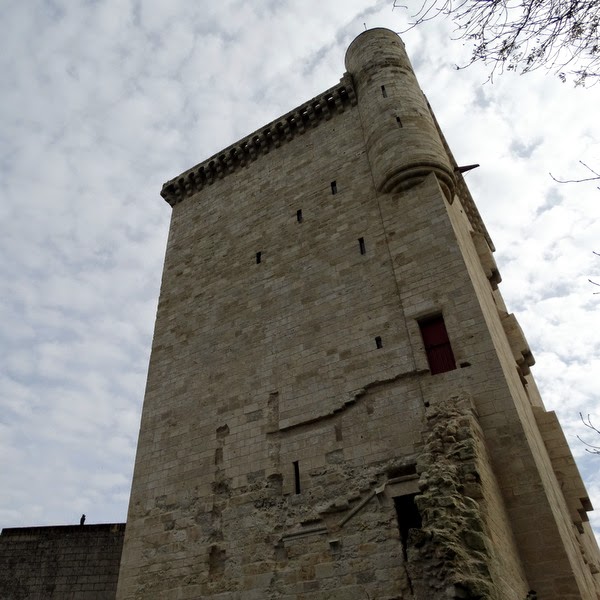What is 30 metres high, 12 metres wide, made of stone and dates way back to the 14th century? The answer, if you happen to be 65 kilometres to the north of Bordeaux in Lesparre-Médoc, is the magnificent “Tour de l’Honneur”.
The 6-level tower (other than the ground floor, there are four levels each comprising a vaulted room, plus a rooftop terrace), is the sole surviving section of the even grander “Château de l'Honneur de Lesparre”, parts of which even predated the 14th century. The original fortified castle comprised three further towers and was a pivotal means of defence for the Médoc and Gironde Estuary, the area being of strategic importance during medieval times.
 |
| The way it was, from different angles and in different states of disrepair, with the surviving tower clearly visible on both pictures. Sources: Patrimoine de France and Médoc Mon Amour websites. |
As such, the fortress was notably a key symbol of British rule in the
area from 1154 - when Eleanor of Aquitaine married Henry, Duke of
Normandy, later Henry II of England - until 1453 and the Battle of
Castillon, which marked the end of the Hundred Years’ War. It belonged
to members of the most powerful house among the local nobility, “les sires de Lesparre”, who controlled
much of the area. It then successively became the property of various
local aristocracies, including the d’Albret, de Matignon and d'Épernon
families.
The latter, led by the Duke d'Épernon himself, drew up substantial plans
in the 17th century to entirely restore what had become crumbling
heritage. A Dutchman named Van der Hem was called on to conceive the designs, but the plans were never rolled out. Then the French Revolution
came along and the castle was sold off as State property.
Surveys dating from the middle of the 19th century show that the area still comprised a moat, further towers and a chapel around that time. But in the ensuing years every section came to be dismantled (much of the castle was reportedly used to build a bridge) until all that remained was this, the master tower, or “donjon”.
Surveys dating from the middle of the 19th century show that the area still comprised a moat, further towers and a chapel around that time. But in the ensuing years every section came to be dismantled (much of the castle was reportedly used to build a bridge) until all that remained was this, the master tower, or “donjon”.
 |
| Details to be spotted, including a flag sporting a very British lion and an ornamental owl that possibly doesn't date from the 14th century. |
In 1913, the surviving tower was at least officially listed as an
historic monument and its status as a symbol of the past glories of
Lesparre and an example of military architecture in medieval times is
now well-cemented. The tower has since become home to a small museum
given over to local history, showcasing old tools and implements, and
various objects uncovered during archaeological digs.
The museum is open throughout the summer period, stretching from June to
September, and by appointment during the remaining months of the year.
And to get an idea of what you can see on the inside (and from the terrace), click this way!
- Find it on the Invisible Bordeaux map:
- Tour de l'Honneur, Rue Pierre-Curie, Lesparre-Médoc













0 commentaires: